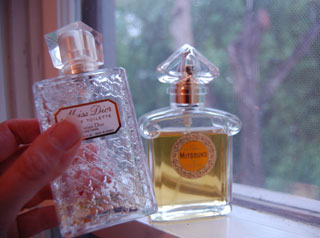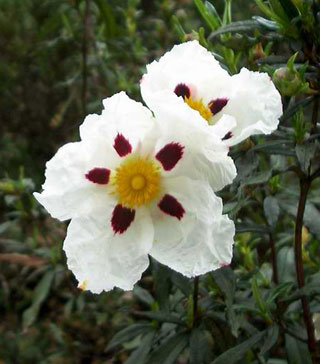Human Flower Project
Wednesday, November 22, 2006
Chypre by the Dozen
Francois Coty’s concoction endures on a million pulse points.

Two intimate friends from the same fragrance family
Photo: Julie Ardery
The first perfume we remember was Ma Griffe (“My Signature”), our mother’s favorite through the late ‘50s and ‘60s. It was green and a little bit sharp, less like dreaming on a couch stuffed with rose petals than walking in an olive grove and biting down on a sliver of lemon rind. Our own first perfume (not counting Ambush, the herd-fragrance of junior high school) was Dioressence. It too delivered a bite, but spicier. When Dioressence disappeared from the shelves for several years and came back as a dud, we switched to Miss Dior. Our new favorite is an old Guerlain: Mitsouko. Again, there’s that pungent, wake up and wonder feeling, slightly musty and not-so-sweet.
All these fragrances, we’ve since learned, are classified as chypres, “based on oakmoss, ciste-labdanum, patchouli and bergamot.” The name is French for Cyprus, and one delight of these perfumes is that they are reminiscent of the herbs and wild plants of a Mediterranean island, tingly and dry.
 Francois Coty, who created the original Chypre
Francois Coty, who created the original Chypre
Photo: Histoire de Francois Coty
Chypre was also the name of the perfume Francois Coty created in 1917 from this combination of scents. When the public fell in love with his perfume, other houses scrambled to concoct something similar. Mitsouko, from 1919, is sometimes classed a fruity-chypre, and contains peach, rose and, we think, a dash of pepper. Others, like Miss Dior, with jasmine and gardenia, are more flowery.
 Cistus Ladanifer, an ingredient in many chypre perfumes
Cistus Ladanifer, an ingredient in many chypre perfumes
Photo: Paghat’s Garden
According to the the International Perfume Museum in Grasse, these sharper, mossier scents began a new era. Here was a change not just of style but of sociology: “While perfumes remain elitist and limited in distribution right up to the First World War, Coty’s ‘Chypre’ breaks with tradition in 1917 by proposing the first perfume for the masses which will encounter an exceptional public reception.” This family of fragrances dominated perfumes until about 1950, when new synthentic ingredients (think Chanel No. 5) swerved the industry in yet another new direction.
Fondness for particular scents or types of scents is mysterious—one of the last experiences on earth that cannot be captured on a cell-phone camera. This piece from the Observer (UK) is entertaining and instructive too. It makes clear why in sampling perfumes one has to be patient, spritzing a little on, then waiting a half hour or more to let the middle and base notes assert themselves. This site gives a good basic explanation of fragrance families, and this one is downright encyclopedic. It classifies 149 perfumes as chypres.
Femme, Fendi, Ysatis…so many fragrances, so little time!




